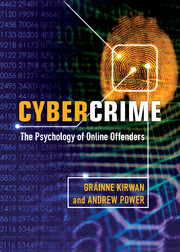Book contents
- Frontmatter
- Contents
- Detailed contents
- List of illustrations
- List of tables
- Preface
- 1 Psychology of cybercrime
- 2 Cybercrimes and cyberlaw
- 3 Hackers
- 4 Malware
- 5 Identity theft and fraud
- 6 Child predation and child pornography online
- 7 Cyberbullying and cyberstalking
- 8 Digital piracy and copyright infringement
- 9 Cyberterrorism
- 10 Crime in virtual worlds
- References
- Index
7 - Cyberbullying and cyberstalking
Published online by Cambridge University Press: 05 July 2013
- Frontmatter
- Contents
- Detailed contents
- List of illustrations
- List of tables
- Preface
- 1 Psychology of cybercrime
- 2 Cybercrimes and cyberlaw
- 3 Hackers
- 4 Malware
- 5 Identity theft and fraud
- 6 Child predation and child pornography online
- 7 Cyberbullying and cyberstalking
- 8 Digital piracy and copyright infringement
- 9 Cyberterrorism
- 10 Crime in virtual worlds
- References
- Index
Summary
Case studies
Christina was happy in school until a new girl, Emma, started in her year. Emma made friends easily, and soon was the most popular girl in the class, but she took a dislike to Christina. Emma began to bully Christina in school – regularly calling her names and insulting her. Christina realised that she was no longer being invited to social events with her former friends, and she spent more and more time alone. While her classmates remained her ‘friends’ on social networking sites, they often sent her bullying messages, or posted nasty comments about her on their profiles. Christina was particularly upset when one person whom she had considered to be a good friend posted information that Christina had told her in secret on the public pages of the social networking site. The bullying soon extended to receiving text messages on her mobile phone, often from numbers that she did not recognise. While Christina tried to remain positive, she found herself becoming more and more introverted and depressed.
Alex had dated Sarah for three months during their first year in university, before breaking it off with her. He thought that they could remain friends, but over time it became apparent that she was stalking him. She commented on every post that he made on social networking sites, and sent him repeated emails and text messages asking to get back together. When Sarah started to show up at parties and events that he was attending, Alex realised that she was using a calendar on a social networking site to figure out where he would be. She also used his online profile to determine what subjects he was taking, and could regularly be found outside the lecture theatre just before or after his classes. She also monitored his location check-ins using his smartphone, and would show up nearby. Eventually Alex blocked her from his social networking account, and changed his mobile phone number so that Sarah couldn’t reach him.
- Type
- Chapter
- Information
- CybercrimeThe Psychology of Online Offenders, pp. 147 - 168Publisher: Cambridge University PressPrint publication year: 2013



